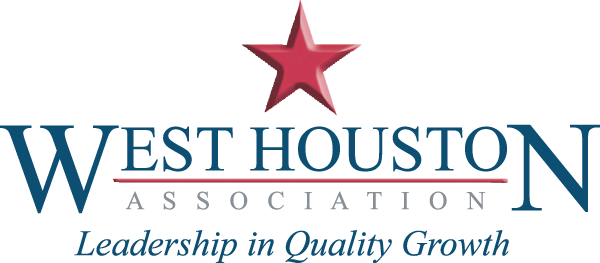Continued growth projected for West Houston will place pressure on our region’s mobility infrastructure. WHA’s Regional Mobility Committee encourages coordinated, reliable, and safe multimodal transportation systems by planning and providing early developmental support of major transportation initiatives for the Greater West Houston region.
WHA Regional Mobility Committee
Explanation of the WHA Regional Mobility Committee
Continued growth projected for Greater West Houston will place pressure on our region’s mobility infrastructure for residents, delivery of goods, products and services, and resiliency during extreme events. Funding new transportation improvements and simply maintaining existing infrastructure under current conditions will be challenging.
The West Houston Association encourages coordinated, reliable, and safe multimodal transportation systems that connect neighborhoods to employment, retail, entertainment, and education centers and that connect the region to national and international trade, commerce, and opportunities.
—————————
GROWTH
Growth. Regional mobility remains a critical challenge facing Greater West Houston. Our region requires major upgrades to its transportation infrastructure. Adequate funding for this infrastructure is critical.
Protect Funding. Billions of dollars will be needed to expand and build new facilities as well as maintain our investment in existing mobility infrastructure. While state and federal leaders recently provided more funding, traditional financing sources will not be sufficient to build needed infrastructure.
Public-Private Partnerships. Public-private partnerships are providing a way to augment the delivery and quality of roadway improvements. Park Row from Dairy Ashford to Barker Cypress was completed through a “380 Agreement” between the City of Houston, the Energy Corridor Management District, and area developers. Kingsland Boulevard (substantially complete) is also a public-private project. These two roads provide vital east-west transit parallel to I-10 on both the north and south sides of the Interstate. Texas Heritage Parkway is a public-private partnership that boasts roundabouts, pedestrian tunnels, and other design features. It will provide a safe, attractive, and efficient north-south corridor to drastically improve residential mobility in Fort Bend County.
Dynamic Pricing. As noted in the 2050 Plan and demonstrated by regional tollways, many users are willing to carpool and pay for mobility improvements. Dynamic pricing for programmed lanes provides a market-based approach that helps ease congestion and generate revenue for projects that could not be built otherwise.
REGIONAL
Regional Challenge. Multiple transportation providers focused on their own service areas present a challenge for regional planning. Regional Vision. We need stronger regional coordination of all transportation providers, including TxDOT, METRO, counties, and cities. This vision requires stronger and more responsive leadership to maximize public investment. Partnerships between METRO and other transit service providers, like the Woodlands Township and Fort Bend County have been successful and can improve regional mobility.
Regional Vision. We need stronger regional coordination of all transportation providers, including TxDOT, METRO, counties, and cities. This vision requires stronger and more responsive leadership to maximize public investment. Partnerships between METRO and other transit service providers, like the Woodlands Township and Fort Bend County have been successful and can improve regional mobility.
ROADS
Road Network. Our traditional spoke-and-wheel system worked well as a solution for areas closer to the city. The effectiveness of the spoke-and-wheel system diminishes as the distance increases and lateral connectors become less robust or non-existent. As growth continues outward from the city more transportation connectors and transit options are needed. Major thoroughfares such as FM 529, FM 1463, Spring Green Boulevard, Betka Road, and Texas Highway 36A are key roadway connectors that can fill the gaps in the spoke-and-wheel system.
Preserve Corridors. The public sector should work cooperatively with property owners to expand rights-of-way and facility options along key roadways and at key intersections ahead of development. The public sector should also consider the width of these corridors to allow for multiple modes of transportation. Planners must responsibly work with and around sensitive areas such as reservoirs and the Katy Prairie to preserve the environment and mobility. Elevating key roadways, such as Eldridge, through reservoirs will reduce impacts and maintain the reservoir capacity and mobility during extreme weather events.
TRANSIT
High-Capacity Transit Conflict. High-capacity transit options, such as high-speed rail, commuter rail, bus rapid transit, and conceivably the hyperloop, can provide tremendous support to quality growth. The desirability of high capacity transit must be planned and operated to minimize conflicts with other transit modes and land uses.
Higher Grade Transit. High-capacity transit should be elevated or on a different grade at major thoroughfare crossings and in heavily urbanized areas. Grade separations increase safety, reduce travel times, preserve urban connectivity, and minimize potential drainage issues sufficiently to justify their costs.
URBAN FABRIC
Dense But Dispersed. Concentrated growth is likely to continue around existing regional centers like Westchase, Memorial City, and the Energy Corridor. This trend will likely continue along the I-10, Beltway 8, and Grand Parkway corridors, especially at major intersections. Many Master Planned Communities (MPCs) are creating town centers at or near key intersections. Concentrated growth will require enhanced transit connection.
Regional Center Connections. Greater West Houston needs a variety of transportation choices (high-capacity transit, circulators, bikes). Encouraging regional centers with mixed-uses, recreational amenities, hospitals, jobs, colleges, and well-planned multi-modal connections will reduce congestion on major routes and improve safety and quality of life. Management Districts and economic development corporations are important facilitators of regional centers, providing planning and services that attract businesses and residents. Reliable last-mile transit service is critical for the success of high-capacity transit systems.
Improved Routes & Intersections. Improving major thoroughfare with smart signalization, lane programming, and grade separations at key intersections will relieve pressure near neighborhoods and along major routes that connect to these centers.
Integrated Public Transit. Reliable transit options, preferably offered by both the public and private sectors, should promote enhanced connectivity between home to work and other destinations. Transit providers should improve connectivity between and within regional centers with first-mile/last mile options that connect to mass transit.
FREIGHT
Freight Confilct. Incidents involving freight traffic, both wheeled and rail, account for over 30% of non-recurring traffic delays in the Houston area. Regional growth will continue to create conflict with freight rail due to accidents and delayed vehicle mobility at road crossings at grade.
Freight Fixes. Investments to improve freight mobility can greatly reduce congestion and improve air quality. Elevated road crossings at key rail intersections must be given a preference to reduce conflicts and maintain mobility. Improving incident response and altering delivery schedules are among the most cost-effective mobility improvements available.
AVIATION
Aviation Issues. Houston’s two international airports, bush (IAH) and Hobby (HOU) and Ellington Field, Currently upgrading from an air force base into a space port, will serve most of Houston well. Greater West Houston’s airports, such as West Houston Executive Airport and West Houston Airport, provide substantial economic benefits but are also critical in disasters. During Harvey, these airports served as strategic logistics points for relief and medical supplies, first responders, and medical evacuation. Development around GWH and limited funding may impact their long term viability to serve our area.
Aviation Opportunities. Protecting the integrity of airspace around these airports will ensure that they provide both economic and strategic value. Optimizing these assets for future use is critical. Extending the West Houston Airport’s runway would likely increase its $25 million in annual economic benefit by approximately 50% within three years, meaning that the project would pay for itself in two to five years. These airports may also provide space for drones and emerging aviation options, which have the potential to disrupt traditional freight and mobility industries.


